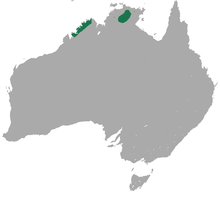- Nabarlek
-
For other uses, see Nabarlek (disambiguation).
Nabarlek[1] Conservation status Scientific classification Kingdom: Animalia Phylum: Chordata Class: Mammalia Subclass: Marsupialia Order: Diprotodontia Family: Macropodidae Genus: Petrogale Species: P. concinna Binomial name Petrogale concinna
Gould, 1842
Nabarlek range The Nabarlek (Petrogale concinna), also known as the Pygmy Rock-wallaby or the Little Rock-wallaby, is a very small species of macropod found in northern Australia. It was formerly considered distinct enough to be assigned its own genus, Peradorcas, but it is now considered to belong, like the rest of the rock-wallabies, in the genus Petrogale.[1]
The Nabarlek was, until the discovery of the Monjon (Petrogale burbidgei) in 1978, the smallest rock-wallaby. It is generally grey with rufous tinges and patches of black around its body, and is a nocturnal, semi-gregarious grazer of grasses and other vegetation.[3] It is classified as near threatened by the IUCN.
The Nabarlek is found in three distinct population areas: in Arnhem Land (including Groote Eylandt); between the Mary and Victoria Rivers in the Top End; and the coastal Kimberley region of Western Australia, including some islands in the Bonaparte Archipelago. It is also found in Kakadu National Park.[3]
The Nabarlek is most closely related to the Monjon and to the Short-eared Rock-wallaby (Petrogale brachyotis).[1]
Three subspecies of the Nabarlek have been recognised:
- P. c. concinna - the Top End population;
- P. c. canescens - the Arnhem Land population;
- P. c. monastria - the Kimberley population.
References
- ^ a b c Groves, C. (2005). Wilson, D. E., & Reeder, D. M, eds. ed. Mammal Species of the World (3rd ed.). Baltimore: Johns Hopkins University Press. pp. 67. OCLC 62265494. ISBN 0-801-88221-4. http://www.bucknell.edu/msw3.
- ^ Woinarski, J., Burbidge, A., Telfer, W., McKenzie, N. & Start, T. (2008). Petrogale concinna. In: IUCN 2008. IUCN Red List of Threatened Species. Downloaded on 28 December 2008. Database entry includes justification for why this species is data deficient
- ^ a b Menkhorst, Peter (2001). A Field Guide to the Mammals of Australia. Oxford University Press. p. 126.
External links
Categories:- IUCN Red List data deficient species
- Macropods
- Mammals of Western Australia
- Mammals of the Northern Territory
- Marsupials of Australia
- Diprotodont stubs
- Western Australia stubs
Wikimedia Foundation. 2010.

